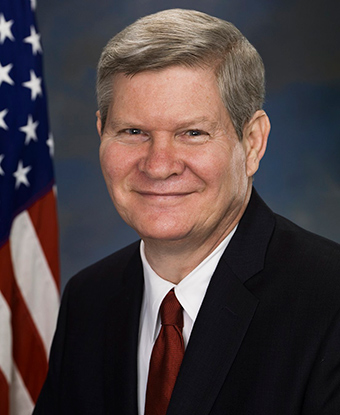Last updated: September 9, 2021
Person
Senator Tim Johnson

US Senate
Senator Tim Johnson was born December 28, 1946 in Canton, South Dakota. A lifelong resident of South Dakota, he decided to run for public office in 1978 when he was elected to the U. S. House of Representatives. In 1996 he ran and was elected to the U. S. Senate where he served until 2015. Senator Johnson was a Freshman Senator during the time period that the legislation establishing Minuteman Missile National Historic Site was being debated in the Senate and provides some insight into the formation of this as a National Park Service site.
Senator Johnson was interviewed for the park's oral history collection in October 2006. Below are several excerpts from his interview:
Did you have thoughts regarding the moral issues about nuclear weapons?
My thinking was that we ought to negotiate a nuclear arms treaty, and I was very supportive of that endeavor because the fewer nuclear weapons there are in the world, the better. But I felt that we did need to negotiate from a position of strength, and that so long as the Soviet Union had a significant nuclear weapons capability that the United States would need to also have that capability, over time of course we moved away from minuteman missile, put much more emphasis on under water nuclear weapon capabilities. And decreased the total numbers of war heads, and so I was concerned about, very concerned about nuclear war, um, but felt that unilateral disarmament in the part of the United States was that there was no moral imperative that we go down that road.
Did you hear from constituents about nuclear missiles very often?
Not a lot, I think there was pretty broad public support for the missile wing, some regarded it as economic development, brought jobs and economic activity to western South Dakota. I can still recall the Wall Drug signs along the interstate advertising free coffee for the missile wing personal, and donuts, free coffee and donuts. And so there was, basically pretty strong sense of pride actually that South Dakota was the host. At least western South Dakota was a host of the missile wing.
You and Senator Daschle sponsored the bill to create the Minuteman Miisle National Historic Site; can you share some insights into the process of park creation?
Well we introduced legislation in the hundred and fifth congress and we were able to get it through the Senate on unanimous consent in October of nineteen ninety-eight but the House Armed Services committee failed to take up the issue it was not taken out of committee and so the whole thing died at the end of the hundred and fifth. When the hundred and sixth congress [reconvened] we reintroduced the legislation again with Senator Daschle as a co-sponsor, passed it by UC in March of nineteen ninety-nine. That the time the house passed it by voice vote in November of nineteen ninety-nine, President Clinton signed into law then at the end of November of nineteen ninety-nine, and so I think the only question that we had in committee at that time was, was this going to create an additional cost for the National Park Service at a time when its budget was already strapped. Did we need to have new park service locations and it took a little bit of convincing, but we persuaded our colleagues in the Senate and in the House that ... it would not, entail a significant new administrative maintenance cost. And reminding people that one of the justifications for this particular site it is was one of the least changed of all, of all the sites. And it was at close proximity to an interstate highway ... and so it made sense and would not be a big cost issue, so the second time around we got it done. ... the important thing was to preserve the site first of all and to make that it didn’t deteriorate, and we been able to that there maybe more things that we could in terms of interpretive capabilities as time goes gone on, I’m doubtful that the National Historic Site will ever see huge volumes of tourist traffic. This is not Mount Rushmore for one thing the sites are relatively small and can only accommodate a relatively hand full of people at any given time. But I think it’s important that we have these as reminders of what the Cold War was about and I think it is important that we have, that we just not preserve the sites that we properly interpret what the sites mean, and over time that is going to be required, I think a more elaborate, interpretive center than we have.
What is that you’d like to see people reminded of about the Cold War?
Well I’d like to be remind people of the risks that were involved in the Cold War, and South Dakota’s contribution to our national defense and how close we came to, what could’ve been a catastrophic nuclear exchange, and how it ought to be resolved never to allow the world to come that close again to such an all out war.
I’m reminded that of course the minuteman missile national historic site is comprised of the two specific sites, delta one launch control facility and the second site is the delta nine launch facility, this is the only remaining intact nuclear missile complex from the Cold War era, there among the oldest in the nation and the least altered from the original minuteman configuration, South Dakota of course is home to the forty-fourth missile wing, it was home to one hundred fifty missile silos and fifteen launch control facilities scattered across the west, so I guess that’s the only remaining thing I can I think of to note.
